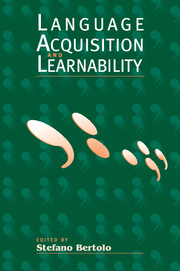3 - Language change and learnability
Published online by Cambridge University Press: 15 October 2009
Summary
Introduction and general hypotheses
For the study of language change to be relevant to learnability theory, a number of assumptions must be made both about language change and about the synchronic form of grammars. The principal assumption is the standard one from principles-and-parameters theory, namely that the grammar of a language L consists of UG principles with the values of the parameters which modulate those fixed principles. This point of view is succinctly stated by Chomsky as follows: “A particular language L is an instantiation of the initial state of the cognitive system of the language faculty with options specified” (Chomsky, 1995: 219). A simple example of this concerns the relative order of a verb and its direct object. In some languages (English, Romance, Bantu, etc.), verbs precede their objects. In other languages (Japanese, Korean, Turkish, Indic, etc.), verbs follow their objects. In terms of principles-and-parameters theory, we say that the existence and characterization of the verb, the direct object and the verb–object relation are to be stated as (or, at the relevant level of theoretical abstraction, derived from) UG principles, while the ordering of the verb and the object are attributable to a parametric choice (this parameter has been referred to as the Head Parameter; see for example, Travis, 1984; Koopman, 1984).
The options in question vary along both the synchronic and the diachronic dimensions.
- Type
- Chapter
- Information
- Language Acquisition and Learnability , pp. 81 - 125Publisher: Cambridge University PressPrint publication year: 2001
- 8
- Cited by



